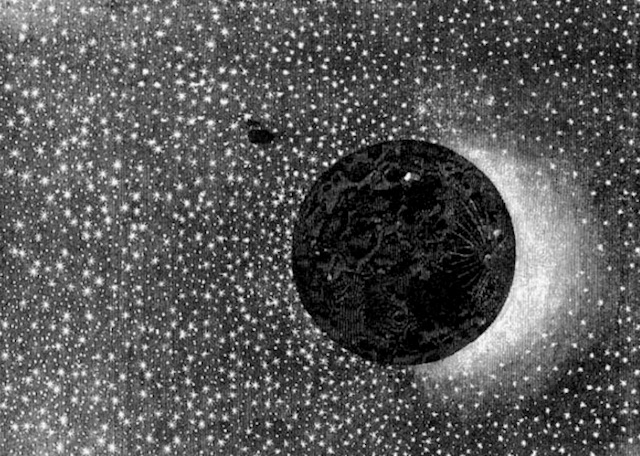
“The moon was reigning over their world, glowing its full splendor to all those willing to look up.” ~ Irina Serban
.
Saturday October 8th is International Observe The Moon Night.
It is an annual event that has been marked to encourage people to look up, observe, appreciate and learn more about our moon (also known as Luna).
The date coincides with another fascinating day, as October 8th is also dedicated to the Norwegian Viking explorer, Erik the Red, infamously known for his unruly red hair and fiery temper. Erik was also father to the famous explorer, Leif Eiríksson.
Following his exile from Norway in 960 A.D., Erik travelled to Iceland, and from there he journeyed on to discover the more hostile, greener pastures of Greenland.
He was a persuasive man and returned to Iceland where he managed to gather together 500 people, as well as animals and supplies, and organized for 25 boats to set sail for Greenland, creating a new existence and giving the country its very first residents.
Erik the Red became the first permanent European settler, and his adventurous streak ran in the family, as his son, Leif, was the first known European to reach Northern America (not Christopher Columbus as we may have previously thought). Leif was also responsible for the first Christian church to be built on Northern American land.
October 8th is a reminder from the universe to tap into our adventurous side and commemorate Erik the Red by embodying his wild spirit, courage, confidence and determination and becoming more aware of the possibilities around us.
This date is the perfect opportunity to plan a star-gazing/moon-gazing evening and to set out for somewhere that we have not yet ventured that has been calling to us loudly.
“The moon—the mandala of the sky.” ~ Tom Robbins
We can take a leaf (or Leif) from Erik’s book, and open our eyes to the awe and wonders of the world, and set an intention to travel and explore more often—to plan road trips, visit new or old friends and to spend time with family members that may live farther afield.
By remembering this iconic legend, we can attune to his bold energy and embrace the kind of self-confidence, strength and belief that Erik was known for, so that we step out into nature with passion and an energetic, fearless and radical, untamed soul.
For those who want to continue celebrating adventurously, October 9th is Lief Eiríksson day. Therefore, this is the perfect opportunity to call up friends and loved ones and plan a Sunday hike, a mountain climb, a trip to the forest or the ocean, or to sit at the side of an enchanting lake and watch the sun set and the moon’s glow take pride of place in the night.
“Tell me the story about how the sun loved the moon so much that she died every night just to let him breathe.” ~ Hanako Ishii
A few facts to ponder while moon gazing this weekend:
The moon’s distance from the Earth is on average 238,000 miles. When the moon first formed, about 4 and a half billion years ago, it was only 14,000 miles away. However, it is slowly inching away from us and in the distant future it will be so far away that it will no longer have such a strong effect on our ocean’s tides.
The moon is just over a quarter of the size of Earth, and the reason it appears so large in the sky is because it is the closest celestial body to us. The diameter of the moon is approximately 2,100 miles.
The moon takes the same amount of time to spin on its axis as it does to orbit the earth, and due to this, we only ever see the same side of the moon. This video explains it perfectly:
We may have heard the term the “dark side of the moon,” but it is just a myth. We only see one side of it as the Earth and the moon are rotating in synchrony; however, the side of the moon that we do not see does receive an equal amount of sunlight. We only perceive the other side as dark, as from Earth we never see the other side.
Although it seems as though the moon changes shape, it is only the light from the sun that gives it this reflective effect. The side of the moon that faces the sun is always lit up—however, due to the positioning of the Earth in relation to the moon, it appears brightly lit or barely visible depending on which stage of the moon phase it is in.
“The moon puts on an elegant show, different every time in shape, color and nuance.” ~ Arthur Smith
The moon moves through an entire phase every 29.5 days, starting with a New Moon, which occurs when the moon is barely visible from Earth. It then waxes, gradually appearing as a sliver and gains more light each day reaching a half moon, and then as the light coverage becomes fuller, it appears as a Full Moon about half way through the phase. From the Full Moon, it is then less visible each day as it wanes and moves through the stages, getting thinner and thinner until it completes the cycle and we reach what is known as a New Moon once again.
To view how mesmerizing the moon looks from the Western hemisphere right now click here.
The moon and our earth have a strong gravitational attraction to one another, which keeps the moon orbiting around us. Even though we may hear that it is the moon that affects the oceans tides, the sun also has a great affect on them too. The gravity from both the sun and the moon pull the Earth’s water towards them and the Earth’s rotation pulls the water back in.
When the sun and the moon are lined up, during a Full Moon or a New Moon, the combined effect is known as “sysygy.” The joint force by the sun and the moon creates a powerful gravitational pull and interacts with the ocean far stronger than normal. This causes the Earth’s water to be pulled upwards and towards the sun and the moon, which is why there are “high tides” during a Full Moon or New Moon.
The moon should be easy to see on October 8th, as it is almost half-full, so it will be clearly visible for most people in the sky if there aren’t too many clouds around. Head out into the night with a blanket, snacks, binoculars and camera—and lie on the ground, stare up at the moon, and take comfort knowing it is always up there, lighting our skies and silently watching over us.
“I like to think that the moon is there even if I am not looking at it.” ~ Albert Einstein
This will be the perfect opportunity to take pictures of the sky and join the social media movement on October 8th by sharing them with the hashtag #observethemoon.
There are moon gatherings being held all over the world to mark the event. Click here to find out if there is one near you.
“You cannot look up at the night sky on the planet Earth and not wonder what it’s like to be up there amongst the stars. And I always look up at the moon and see it as the single most romantic place within the cosmos.” ~ Tom Hanks
~
Author: Alex Myles
Images: Wikimedia Commons
Editor: Yoli Ramazzina








Read 0 comments and reply